Chilingarian G.V. et al. Surface Operations in Petroleum Production, II
Подождите немного. Документ загружается.

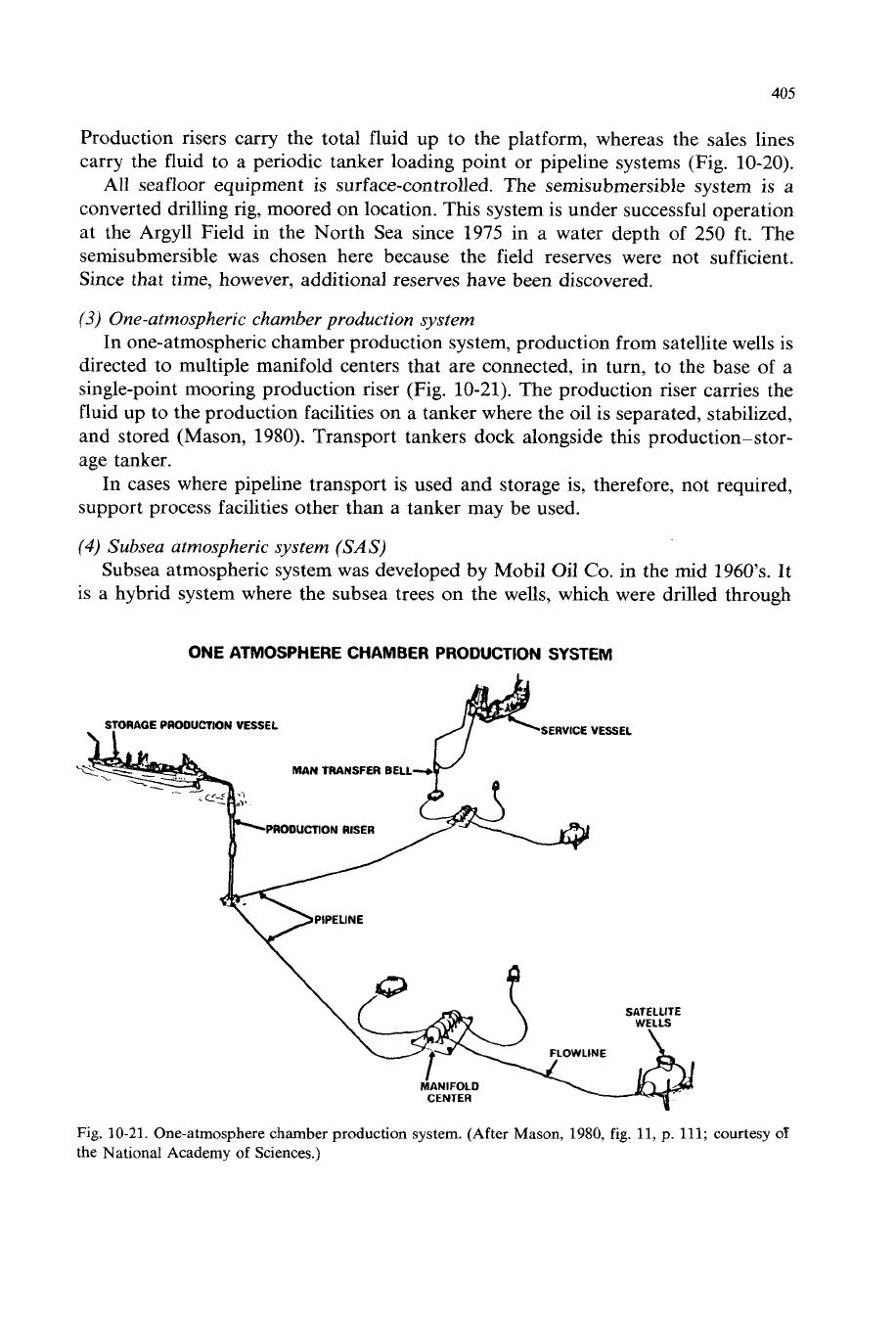
405
Production risers carry the total fluid up to the platform, whereas the sales lines
carry the fluid to a periodic tanker loading point or pipeline systems (Fig. 10-20).
All seafloor equipment
is
surface-controlled. The semisubmersible system
is
a
converted drilling rig, moored on location. Ths system is under successful operation
at the Argyll Field in the North Sea since 1975 in a water depth of 250 ft. The
semisubmersible was chosen here because the field reserves were not sufficient.
Since that time, however, additional reserves have been discovered.
(3)
One-atmospheric chamber production system
In one-atmospheric chamber production system, production from satellite wells is
directed to multiple manifold centers that are connected, in turn, to the base of a
single-point mooring production riser (Fig. 10-21). The production riser carries the
fluid up to the production facilities on a tanker where the oil
is
separated, stabilized,
and stored (Mason,
1980).
Transport tankers dock alongside this production-stor-
age tanker.
In cases where pipeline transport is used and storage is, therefore, not required,
support process facilities other than a tanker may be used.
(4)
Subsea atmospheric system
(SAS)
Subsea atmospheric system was developed by Mobil Oil
Co.
in the mid
1960’s.
It
is a hybrid system where the subsea trees on the wells, which were drilled through
ONE
ATMOSPHERE CHAMBER PRODUCTION SYSTEM
SERVICE VESSEL
STORAQE
PRODUCTION
VESSEL
\I
MAN
TRANSFER BELL-
PRODUCTION
RISER
Fig.
10-21.
One-atmosphere chamber production system.
(After
Mason,
1980,
fig.
11,
p.
111;
courtesy
of
the National Academy
of
Sciences.)
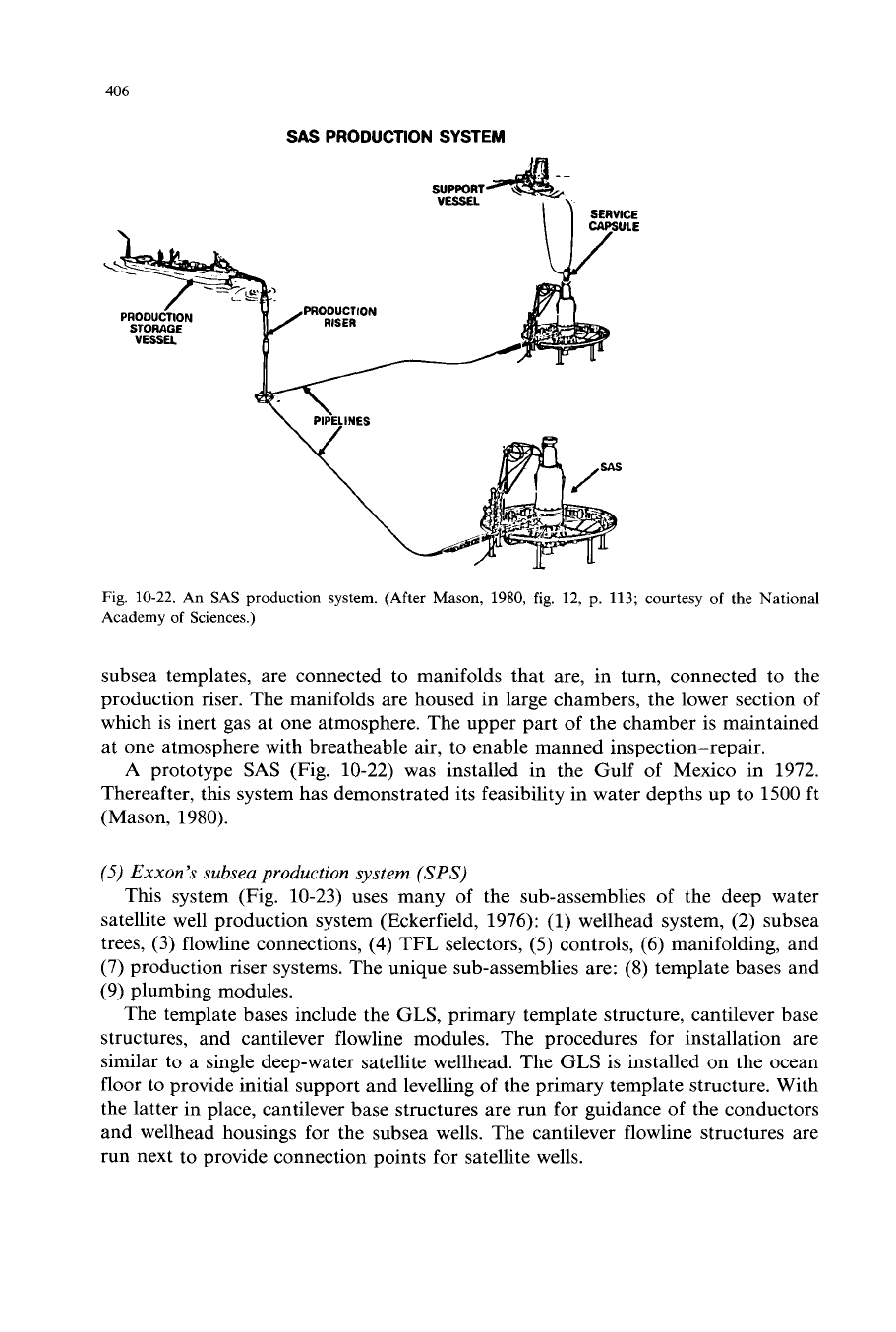
406
SAS
PRODUCTION
SYSTEM
PRODUCTION
RISER
SUPPORT
VESSEL
Fig.
10-22.
An SAS production system. (After Mason,
1980,
fig.
12,
p.
113;
courtesy
of
the National
Academy
of
Sciences.)
subsea templates, are connected to manifolds that are, in turn, connected to the
production riser. The manifolds are housed in large chambers, the lower section of
which
is
inert gas at one atmosphere. The upper part
of
the chamber is maintained
at one atmosphere with breatheable air, to enable manned inspection-repair.
A
prototype
SAS
(Fig. 10-22) was installed in the
Gulf
of Mexico in 1972.
Thereafter, this system has demonstrated its feasibility in water depths up to 1500 ft
(Mason, 1980).
(5)
Exxon’s
subsea production system
(SPS)
This system (Fig. 10-23) uses many
of
the sub-assemblies
of
the deep water
satellite well production system (Eckerfield, 1976): (1) wellhead system, (2) subsea
trees, (3) flowline connections,
(4)
TFL
selectors, (5) controls,
(6)
manifolding, and
(7) production riser systems. The unique sub-assemblies are: (8) template bases and
(9) plumbing modules.
The template bases include the
GLS,
primary template structure, cantilever base
structures, and cantilever flowline modules. The procedures for installation are
similar to a single deep-water satellite wellhead. The
GLS is
installed on the ocean
floor to provide initial support and levelling
of
the primary template structure. With
the latter in place, cantilever base structures are run
for
guidance of the conductors
and wellhead housings for the subsea wells. The cantilever flowline structures are
run next to provide connection points for satellite wells.
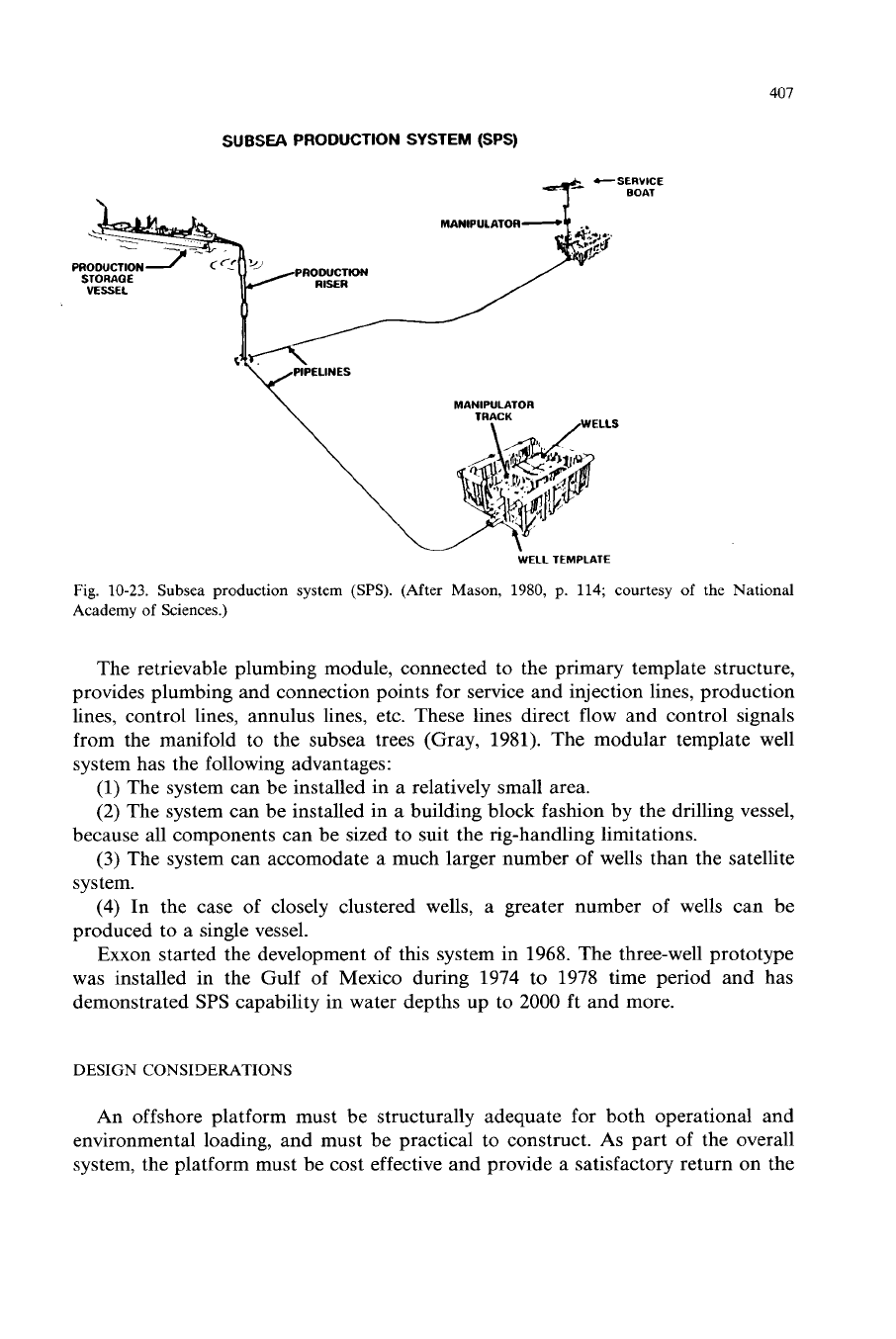
407
SUBSEA
PRODUCTION
SYSTEM
(SPS)
*SERVICE
BOAT
MANIPULATOR-
PRODUCTION
PRODUCTION
VESSEL
MANIPULATOR
WELL TEMPLATE
Fig.
10-23.
Subsea production system
(SPS).
(After Mason,
1980,
p.
114; courtesy
of
the National
Academy
of
Sciences.)
The retrievable plumbing module, connected to the primary template structure,
provides plumbing and connection points for service and injection lines, production
lines, control lines, annulus lines, etc. These lines direct flow and control signals
from the manifold to the subsea trees (Gray, 1981). The modular template well
system has the following advantages:
(1)
The system can be installed in a relatively small area.
(2)
The system can be installed in a building block fashion by the drilling vessel,
because all components can be sized to suit the rig-handling limitations.
(3)
The system can accomodate a much larger number of wells than the satellite
system.
(4)
In the case of closely clustered wells, a greater number of wells can be
produced to a single vessel.
Exxon started the development of this system in 1968. The three-well prototype
was installed in the Gulf of Mexico during 1974 to 1978 time period and has
demonstrated
SPS
capability in water depths
up
to
2000
ft and more.
DESIGN CONSIDERATIONS
An offshore platform must be structurally adequate for both operational and
environmental loading, and must be practical to construct. As part of the overall
system, the platform must be cost effective and provide a satisfactory return on the
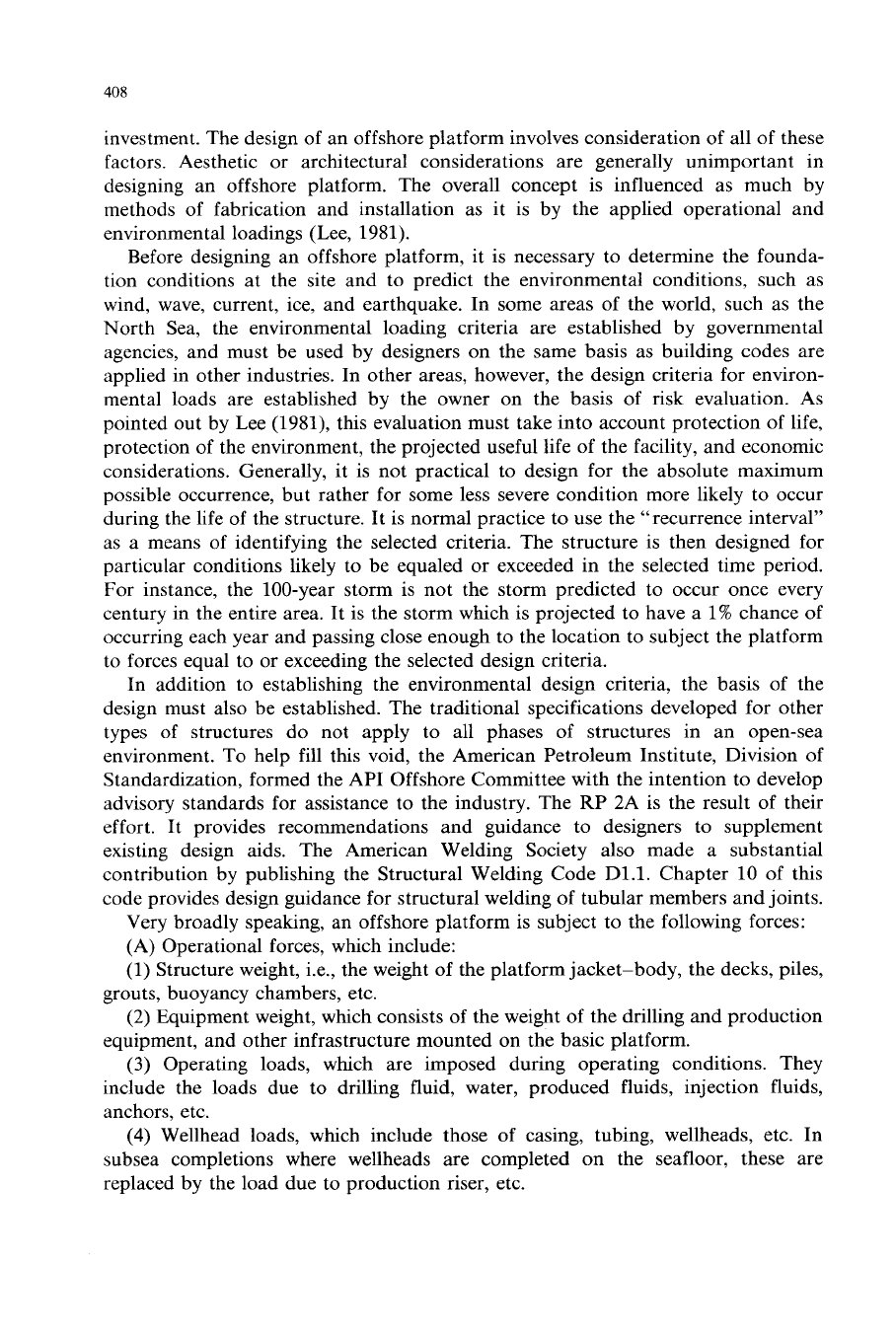
408
investment. The design of an offshore platform involves consideration of all of these
factors. Aesthetic or architectural considerations are generally unimportant in
designing an offshore platform. The overall concept is influenced as much by
methods of fabrication and installation as it is by the applied operational and
environmental loadings (Lee, 1981).
Before designing an offshore platform, it is necessary to determine the founda-
tion conditions at the site and to predict the environmental conditions, such as
wind, wave, current, ice, and earthquake. In some areas of the world, such as the
North Sea, the environmental loading criteria are established by governmental
agencies, and must be used by designers on the same basis as building codes are
applied in other industries. In other areas, however, the design criteria for environ-
mental loads are established by the owner on the basis of risk evaluation. As
pointed out by Lee (1981), this evaluation must take into account protection of life,
protection of the environment, the projected useful life of the facility, and economic
considerations. Generally, it is not practical to design for the absolute maximum
possible occurrence, but rather for some less severe condition more likely to occur
during the life of the structure.
It
is normal practice to use the “recurrence interval”
as a means of identifying the selected criteria. The structure is then designed for
particular conditions likely to be equaled or exceeded in the selected time period.
For instance, the 100-year storm is not the storm predicted
to
occur once every
century in the entire area. It is the storm which is projected to have a
1%
chance
of
occurring each year and passing close enough to the location to subject the platform
to forces equal to or exceeding the selected design criteria.
In addition to establishing the environmental design criteria, the basis of the
design must also be established. The traditional specifications developed for other
types of structures do not apply to all phases
of
structures in an open-sea
environment. To help fill this void, the American Petroleum Institute, Division of
Standardization, formed the API Offshore Committee with the intention to develop
advisory standards for assistance to the industry. The RP 2A is the result of their
effort. It provides recommendations and guidance to designers to supplement
existing design aids. The American Welding Society also made a substantial
contribution by publishing the Structural Welding Code D1.l. Chapter 10 of this
code provides design guidance for structural welding
of
tubular members and joints.
Very broadly speaking, an offshore platform is subject to the following forces:
(A) Operational forces, which include:
(1) Structure weight, i.e., the weight
of
the platform jacket-body, the decks, piles,
grouts, buoyancy chambers, etc.
(2)
Equipment weight, which consists of the weight
of
the drilling and production
equipment, and other infrastructure mounted
on
the basic platform.
(3)
Operating loads, which are imposed during operating conditions. They
include the loads due to drilling fluid, water, produced fluids, injection fluids,
anchors, etc.
(4)
Wellhead loads, which include those of casing, tubing, wellheads, etc. In
subsea completions where wellheads are completed on the seafloor, these are
replaced by the load due to production riser, etc.
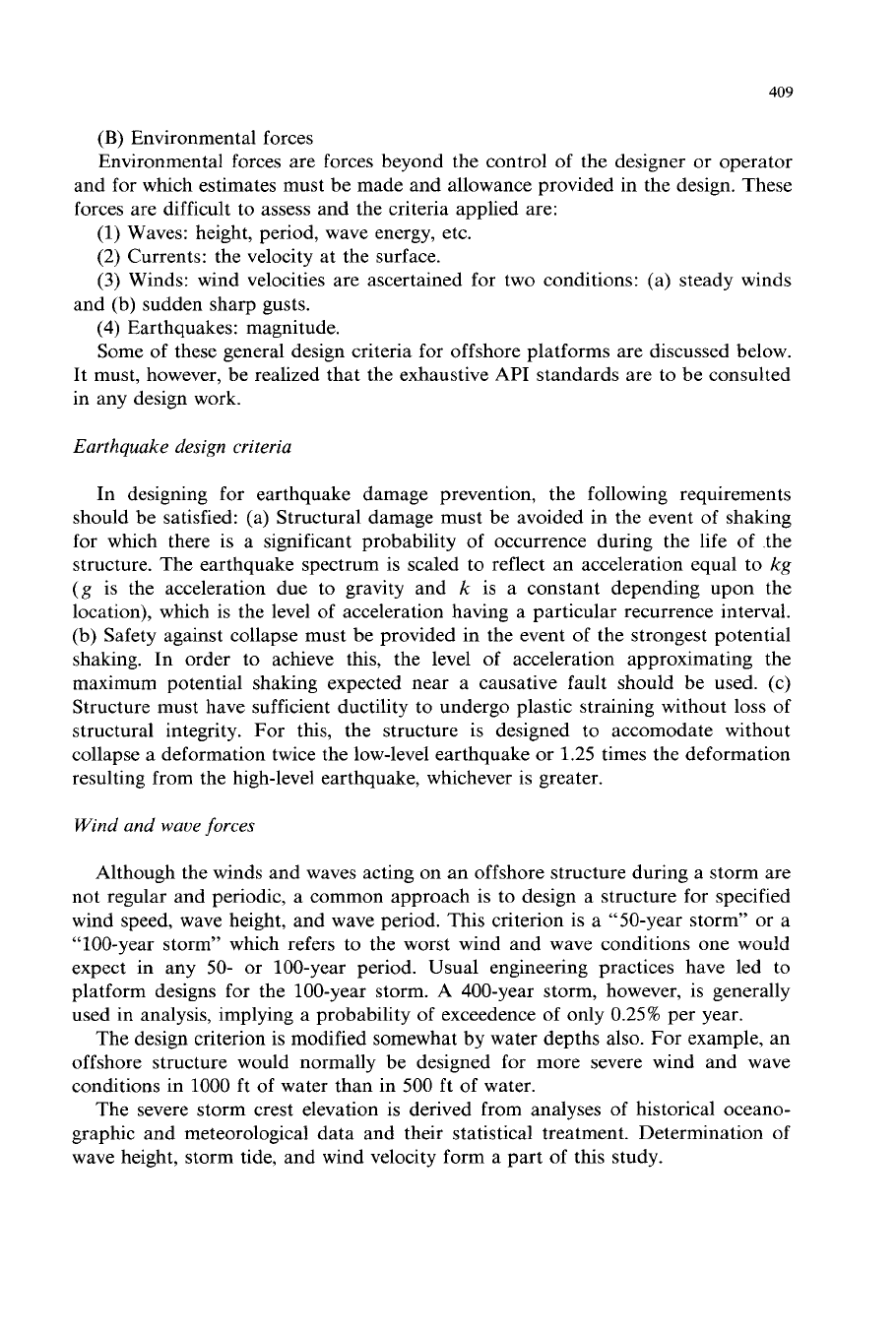
409
(B)
Environmental forces
Environmental forces are forces beyond the control
of
the designer or operator
and for which estimates must be made and allowance provided in the design. These
forces are difficult to assess and the criteria applied are:
(1) Waves: height, period, wave energy, etc.
(2)
Currents: the velocity at the surface.
(3)
Winds: wind velocities are ascertained for two conditions: (a) steady winds
(4) Earthquakes: magnitude.
Some of these general design criteria for offshore platforms are discussed below.
It must, however, be realized that the exhaustive API standards are to be consulted
in any design work.
and (b) sudden sharp gusts.
Earthquake design criteria
In designing for earthquake damage prevention, the following requirements
should be satisfied: (a) Structural damage must be avoided in the event of shaking
for which there is a significant probability
of
occurrence during the life of the
structure. The earthquake spectrum is scaled to reflect an acceleration equal to
kg
(g
is
the acceleration due to gravity and
k
is a constant depending upon the
location), which is the level of acceleration having a particular recurrence interval.
(b) Safety against collapse must be provided in the event of the strongest potential
shaking. In order to achieve this, the level
of
acceleration approximating the
maximum potential shakmg expected near a causative fault should be used. (c)
Structure must have sufficient ductility to undergo plastic straining without loss
of
structural integrity. For this, the structure is designed to accomodate without
collapse a deformation twice the low-level earthquake or
1.25
times the deformation
resulting from the lugh-level earthquake, whichever is greater.
Wind
and wave forces
Although the winds and waves acting on an offshore structure during a storm are
not regular and periodic, a common approach is to design a structure for specified
wind speed, wave height, and wave period. This criterion is a “50-year storm” or a
“100-year storm” which refers to the worst wind and wave conditions one would
expect in any
50-
or 100-year period. Usual engineering practices have led to
platform designs for the 100-year storm. A 400-year storm, however, is generally
used in analysis, implying a probability of exceedence of only
0.25%
per year.
The design criterion
is
modified somewhat by water depths also. For example, an
offshore structure would normally be designed for more severe wind and wave
conditions in 1000 ft
of
water than in
500
ft of water.
The severe storm crest elevation
is
derived from analyses of historical oceano-
graphic and meteorological data and their statistical treatment. Determination of
wave height, storm tide, and wind velocity form a part of this study.
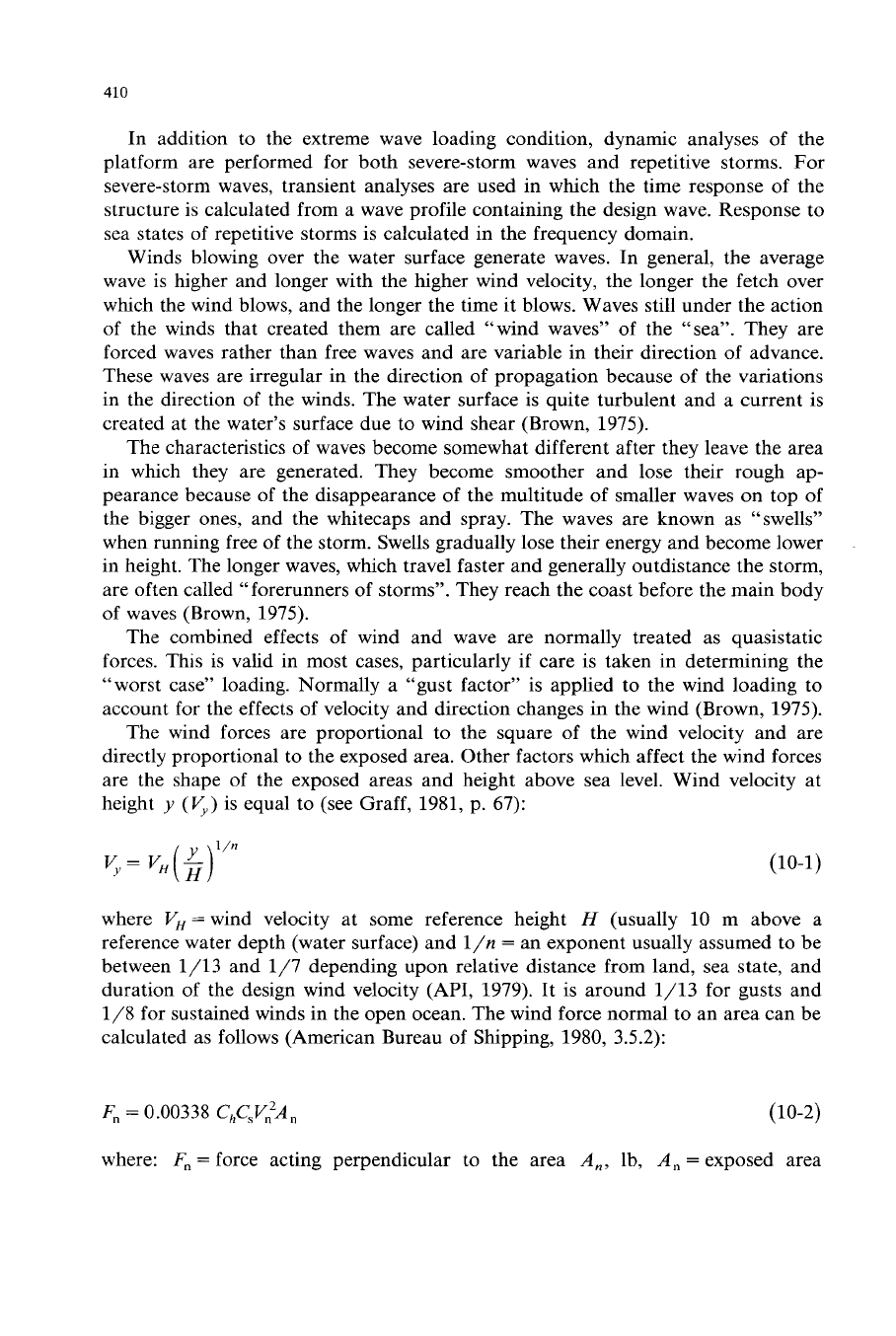
410
In addition to the extreme wave loading condition, dynamic analyses of the
platform are performed for both severe-storm waves and repetitive storms.
For
severe-storm waves, transient analyses are used in which the time response
of
the
structure is calculated from a wave profile containing the design wave. Response to
sea states of repetitive storms is calculated in the frequency domain.
Winds blowing over the water surface generate waves. In general, the average
wave is higher and longer with the higher wind velocity, the longer the fetch over
which the wind blows, and the longer the time it blows. Waves still under the action
of the winds that created them are called “wind waves” of the “sea”. They are
forced waves rather than free waves and are variable in their direction of advance.
These waves are irregular in the direction of propagation because of the variations
in the direction of the winds. The water surface is quite turbulent and a current is
created at the water’s surface due to wind shear (Brown, 1975).
The characteristics
of
waves become somewhat different after they leave the area
in which they are generated. They become smoother and lose their rough ap-
pearance because
of
the disappearance
of
the multitude
of
smaller waves on top of
the bigger ones, and the whitecaps and spray. The waves are known as “swells’’
when running free of the storm. Swells gradually lose their energy and become lower
in height. The longer waves, which travel faster and generally outdistance the storm,
are often called “forerunners of storms”. They reach the coast before the main body
of
waves (Brown, 1975).
The combined effects of wind and wave are normally treated as quasistatic
forces. This is valid in most cases, particularly if care is taken in determining the
“worst case” loading. Normally a “gust factor” is applied to the wind loading to
account for the effects of velocity and direction changes in the wind (Brown, 1975).
The wind forces are proportional to the square of the wind velocity and are
directly proportional to the exposed area. Other factors which affect the wind forces
are the shape of the exposed areas and height above sea level. Wind velocity at
height
y
(5)
is equal to (see Graff, 1981, p.
67):
vy
=
v,
($)””
(10-1)
where
V,
=
wind velocity at some reference height
H
(usually 10 m above a
reference water depth (water surface) and
l/n
=
an exponent usually assumed to be
between 1/13 and 1/7 depending upon relative distance from land, sea state, and
duration of the design wind velocity (API, 1979). It
is
around 1/13 for gusts and
1/8 for sustained winds in the open ocean. The wind force normal to an area can be
calculated as follows (American Bureau of Shipping, 1980, 3.5.2):
F,
=
0.00338
C&V?A,
(10-2)
where:
F,
=
force acting perpendicular to the area
A,,,
lb,
A,
=
exposed area
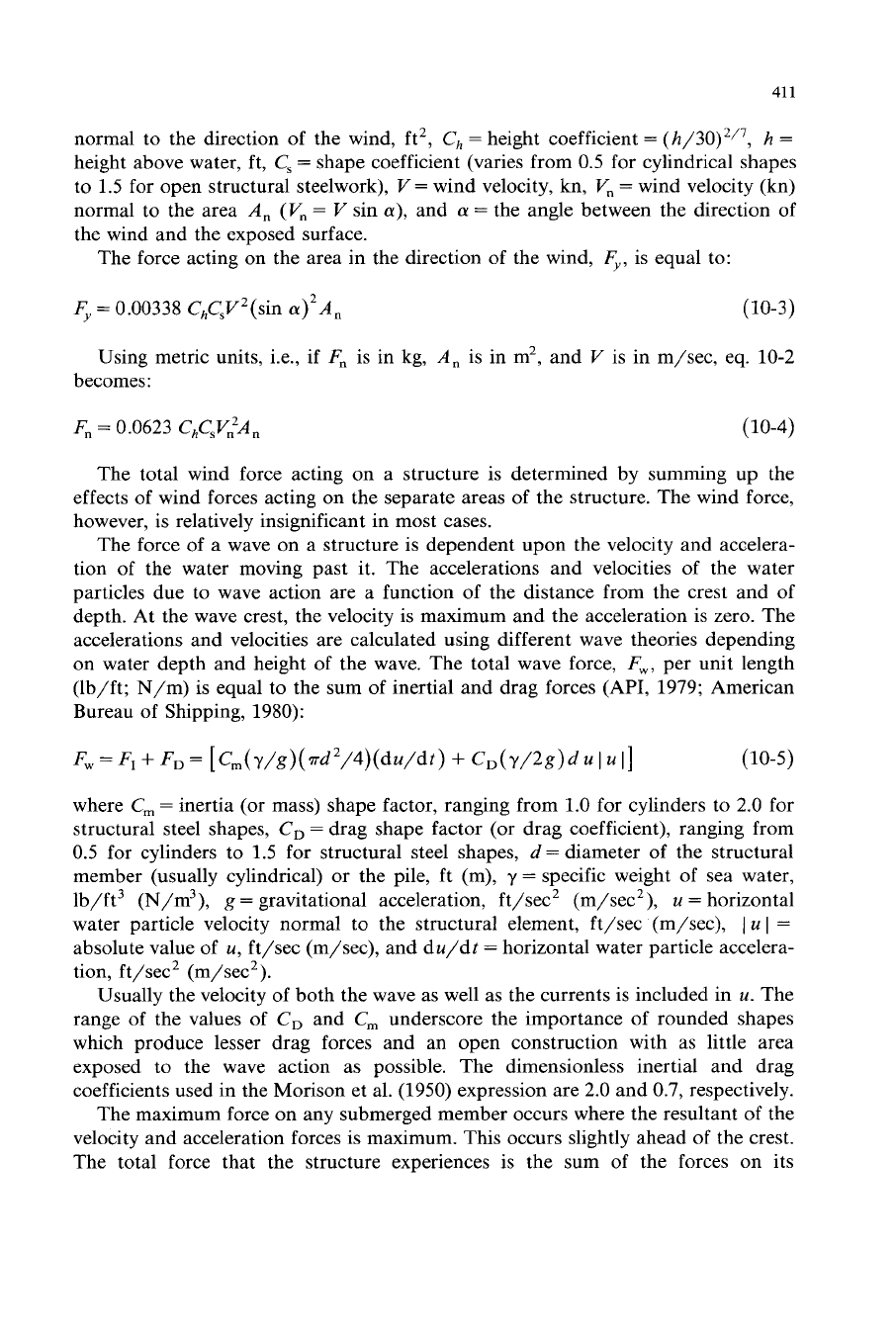
41
1
normal to the direction of the wind, ft’,
c),
=
height coefficient
=
(15/30)~/’,
h
=
height above water, ft, C,
=
shape coefficient (varies from
0.5
for cylindrical shapes
to 1.5 for open structural steelwork), V
=
wind velocity, kn, V,
=
wind velocity (kn)
normal to the area
A,
(V,
=
V sin
a),
and
a
=
the angle between the direction of
the wind and the exposed surface.
The force acting on the area in the direction of the wind,
5,
is equal to:
Fy
=
0.00338 C,C,V’(sin
CX)~A,
(10-3)
Using metric units, i.e., if
F,
is in kg,
A,
is in m2, and
V
is in m/sec, eq. 10-2
becomes:
The total wind force acting on a structure is determined by summing up the
effects of wind forces acting on the separate areas of the structure. The wind force,
however, is relatively insignificant in most cases.
The force
of
a
wave on a structure is dependent upon the velocity and accelera-
tion of the water moving past it. The accelerations and velocities
of
the water
particles due to wave action are a function of the distance from the crest and
of
depth. At the wave crest, the velocity is maximum and the acceleration is zero. The
accelerations and velocities are calculated using different wave theories depending
on water depth and height of the wave. The total wave force,
F,,
per unit length
(lb/ft; N/m) is equal to the sum of inertial and drag forces
(API,
1979; American
Bureau of Shpping, 1980):
where
C,
=
inertia (or mass) shape factor, ranging from 1.0 for cylinders to
2.0
for
structural steel shapes, C,
=
drag shape factor (or drag coefficient), ranging from
0.5
for cylinders to
1.5
for structural steel shapes,
d=
diameter of the structural
member (usually cylindrical) or the pile, ft (m),
y
=
specific weight of sea water,
lb/ft3 (N/m3),
g
=
gravitational acceleration, ft/sec2 (m/sec’),
u
=
horizontal
water particle velocity normal to the structural element, ft/sec (m/sec),
1
u
I
=
absolute value of u, ft/sec (m/sec), and du/dt
=
horizontal water particle accelera-
tion, ft/sec’ (m/sec2).
Usually the velocity of both the wave as well as the currents is included in
u.
The
range of the values of
CD
and C, underscore the importance of rounded shapes
which produce lesser drag forces and an open construction with as little area
exposed to the wave action as possible. The dimensionless inertial and drag
coefficients used in the Morison et al. (1950) expression are
2.0
and 0.7, respectively.
The maximum force on any submerged member occurs where the resultant
of
the
velocity and acceleration forces
is
maximum. This occurs slightly ahead of the crest.
The total force that the structure experiences is the sum of the forces on its
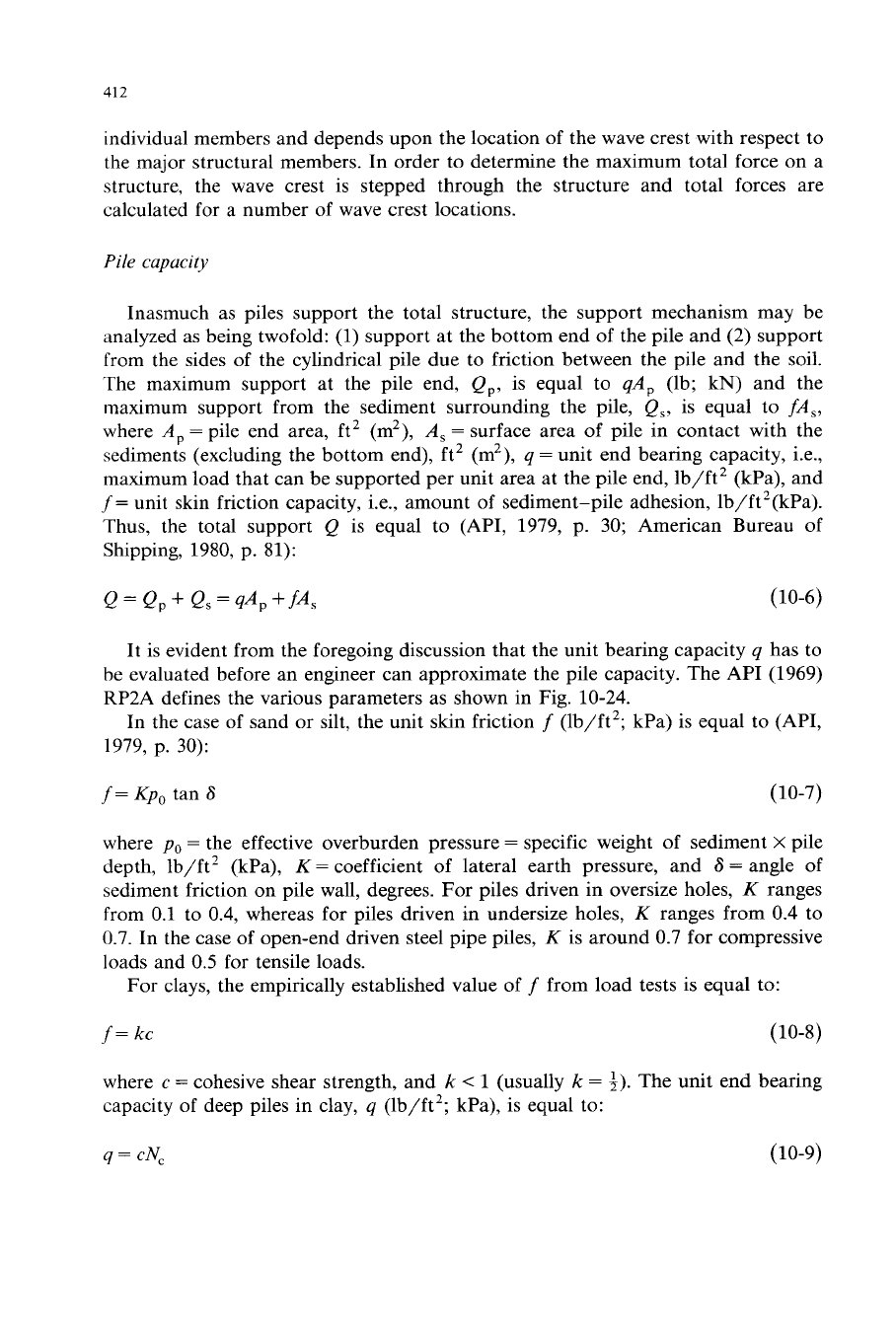
412
individual members and depends upon the location of the wave crest with respect to
the major structural members. In order to determine the maximum total force on a
structure, the wave crest is stepped through the structure and total forces are
calculated for a number
of
wave crest locations.
Pile
capucity
Inasmuch as piles support the total structure, the support mechanism may be
analyzed as being twofold: (1) support at the bottom end
of
the pile and (2) support
from the sides of the cylindrical pile due to friction between the pile and the soil.
The maximum support at the pile end,
Qp,
is equal to
qAp
(lb; kN) and the
maximum support from the sediment surrounding the pile,
Q,,
is equal to
fA,,
where
A,
=
pile end area, ft2 (m2),
A,
=
surface area
of
pile in contact with the
sediments (excluding the bottom end), ft2 (m2),
q
=
unit end bearing capacity, i.e.,
maximum load that can be supported per unit area at the pile end, lb/ft2 (kPa), and
f
=
unit skin friction capacity, i.e., amount of sediment-pile adhesion, lb/ft2(kPa).
Thus, the total support
Q
is equal to (API, 1979, p.
30;
American Bureau
of
Shipping, 1980, p. 81):
Q
=
Qp
+
Q,
=
qAp
+fA,
(10-6)
It is evident from the foregoing discussion that the unit bearing capacity
q
has to
be evaluated before an engineer can approximate the pile capacity. The API (1969)
RP2A defines the various parameters as shown in Fig. 10-24.
In the case
of
sand or silt, the unit skin friction
f
(lb/ft2; kPa) is equal to (API,
1979, p.
30):
f
=
Kp,
tan
6
(10-7)
where
po
=
the effective overburden pressure
=
specific weight of sediment
X
pile
depth, lb/ft2 (kPa), K= coefficient of lateral earth pressure, and
6
=
angle of
sediment friction on pile wall, degrees. For piles driven in oversize holes,
K
ranges
from
0.1
to 0.4, whereas for piles driven in undersize holes, K ranges from 0.4 to
0.7. In the case of open-end driven steel pipe piles,
K
is around 0.7 for compressive
loads and
0.5
for tensile loads.
For clays, the empirically established value
of
f
from load tests
is
equal to:
f=kc
(10-8)
where
c
=
cohesive shear strength, and
k
<
1
(usually
k
=
i).
The unit end bearing
capacity of deep piles in clay,
q
(lb/ft2; kPa), is equal to:
q
=
cN,
(10-9)
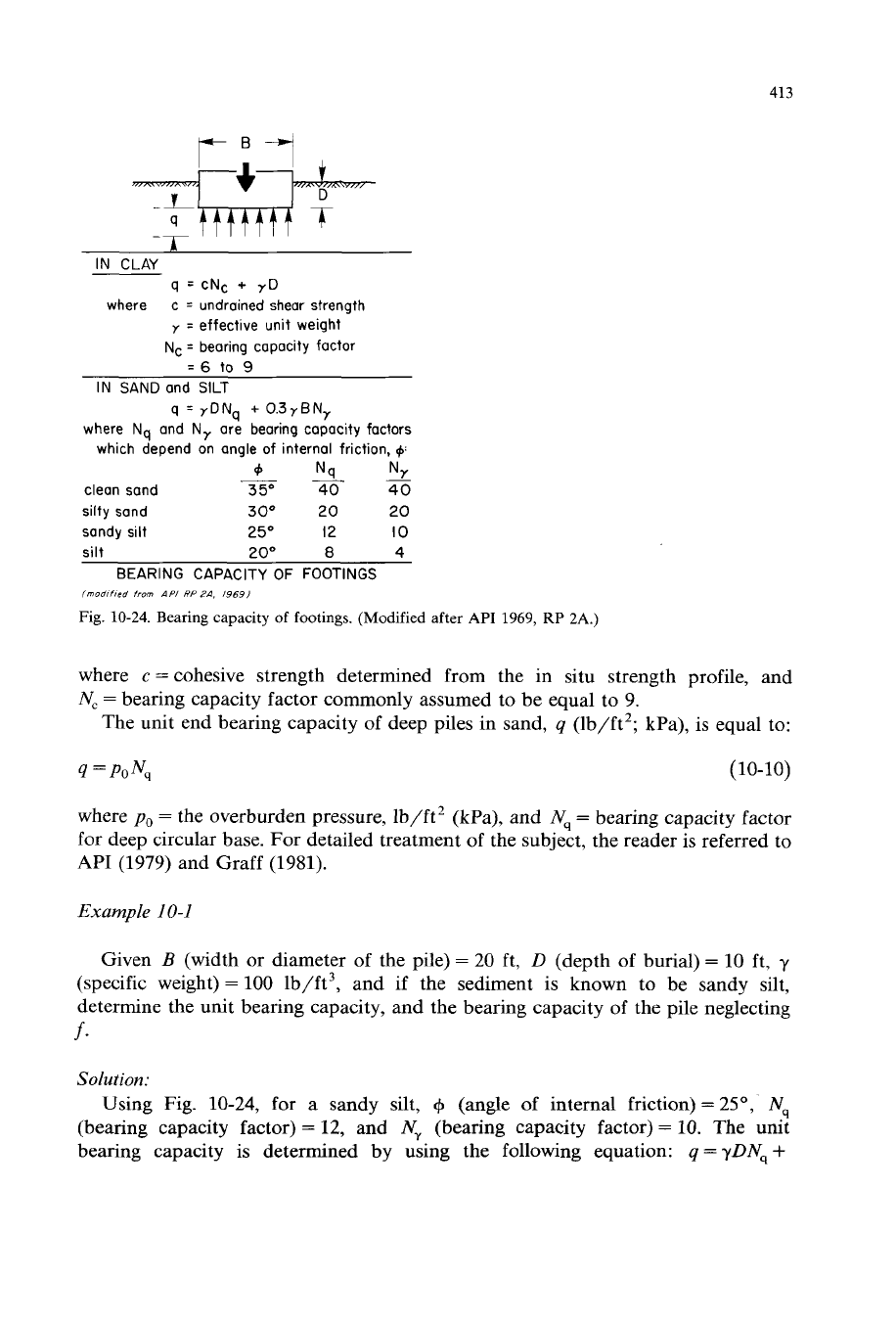
413
IN CLAY
where
q
CNC
+
yD
c
=
undrained shear strength
=
effective unit weight
Nc
=
bearing capacity factor
=6
to
9
IN
SAND
and
SILT
q
=
yDNq
+
0.3yBNy
where
Nq
and
N,
are bearing capacity factors
which depend on angle of internal friction,
+
clean sand
35"
40
40
silty sand
30"
20 20
sandy silt
25" 12
10
silt
20"
8
4
BEARING CAPACITY OF FOOTINGS
____
+
Nq
N,
fmod!f,ed
from
API
RP
ZA,
I9691
Fig.
10-24.
Bearing capacity of footings. (Modified after
API
1969,
RP
2A.)
where c=cohesive strength determined from the in situ strength profile, and
N,
=
bearing capacity factor commonly assumed to be equal to 9.
The unit end bearing capacity of deep piles in sand,
q
(lb/ft2; kPa), is equal to:
4
=
PON,
(10-10)
where
po
=
the overburden pressure, lb/ft2 (kPa), and
N,
=
bearing capacity factor
for deep circular base. For detailed treatment
of
the subject, the reader is referred to
API (1979) and Graff (1981).
Example
10-1
Given
B
(width or diameter of the pile)
=
20 ft,
D
(depth
of
burial)
=
10 ft,
y
(specific weight)
=
100 lb/ft3, and
if
the sediment is known to be sandy silt,
determine the unit bearing capacity, and the bearing capacity
of
the pile neglecting
f.
Solution:
Using Fig. 10-24, for a sandy silt,
$I
(angle
of
internal friction)= 25",
Nq
(bearing capacity factor)
=
12, and
N,,
(bearing capacity factor)
=
10.
The
unit
bearing capacity is determined by using the following equation:
q=
yDN,+
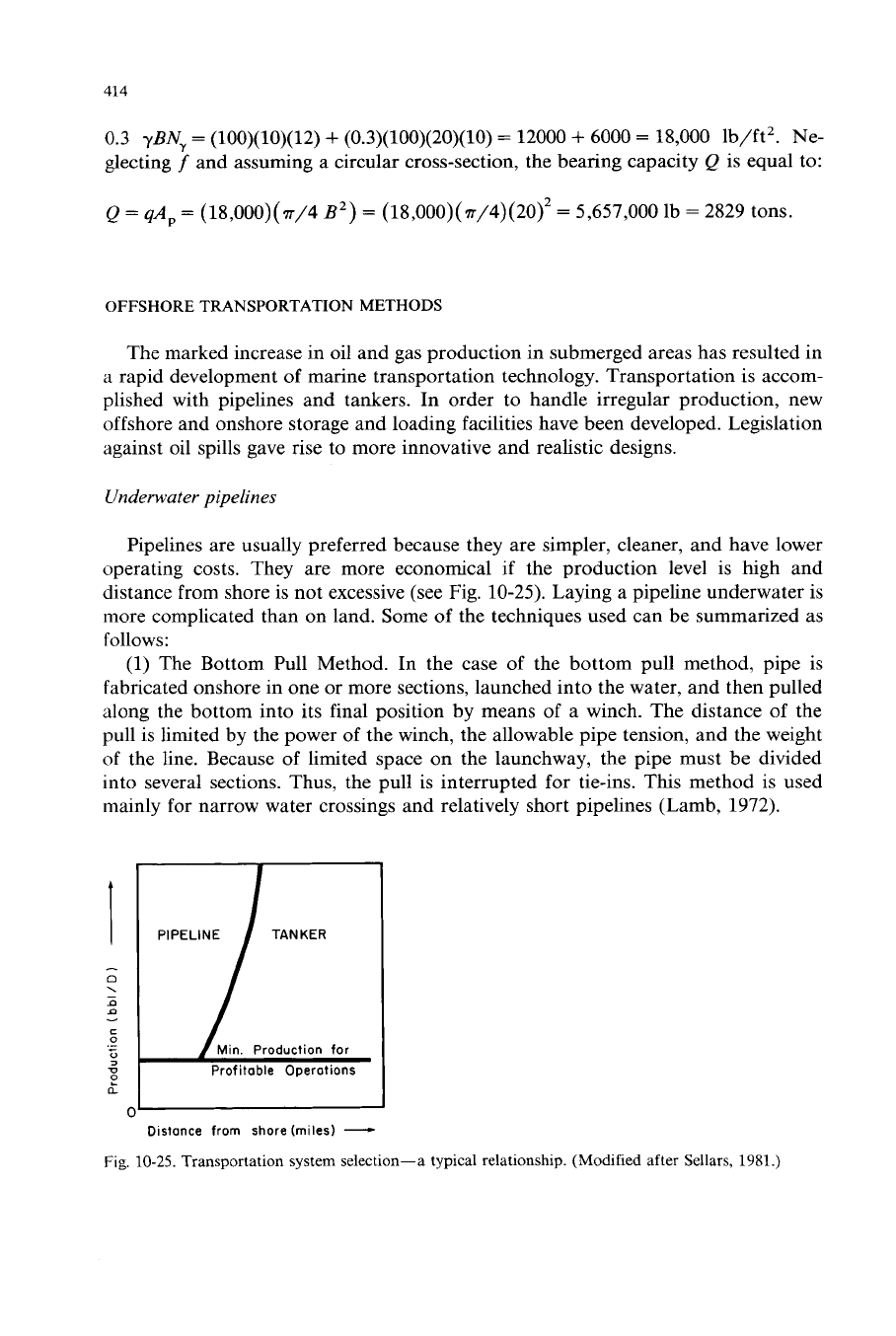
414
0.3
yBN,
=
(100)(10)(12)
+
(0.3)(100)(20)(10)
=
12000
+
6000
=
18,000
lb/ft2. Ne-
glecting
f
and assuming a circular cross-section, the bearing capacity
Q
is equal to:
Q
=
qAp
=
(18,000)( m/4
B2)
=
(18,000)( m/4)(20)’
=
5,657,000
lb
=
2829
tons.
OFFSHORE TRANSPORTATION METHODS
The marked increase in oil and gas production in submerged areas has resulted in
a rapid development of marine transportation technology. Transportation is accom-
plished with pipelines and tankers. In order to handle irregular production, new
offshore and onshore storage and loading facilities have been developed. Legislation
against oil spills gave rise to more innovative and realistic designs.
Underwater
pipelines
Pipelines are usually preferred because they are simpler, cleaner, and have lower
operating costs. They are more economical if the production level is high and
distance from shore is not excessive (see Fig.
10-25).
Laying a pipeline underwater is
more complicated than on land. Some
of
the techniques used can be summarized as
follows
:
(1)
The Bottom Pull Method. In the case of the bottom pull method, pipe is
fabricated onshore in one or more sections, launched into the water, and then pulled
along the bottom into its final position by means of a winch. The distance of the
pull is limited by the power of the winch, the allowable pipe tension, and the weight
of the line. Because of limited space on the launchway, the pipe must be divided
into several sections. Thus, the pull is interrupted for tie-ins. This method is used
mainly for narrow water crossings and relatively short pipelines (Lamb,
1972).
Min. Production
for
a
0
Distance from shore (miles)
-
Fig.
10-25.
Transportation system selection-a typical relationship. (Modified after Sellars,
1981.)
